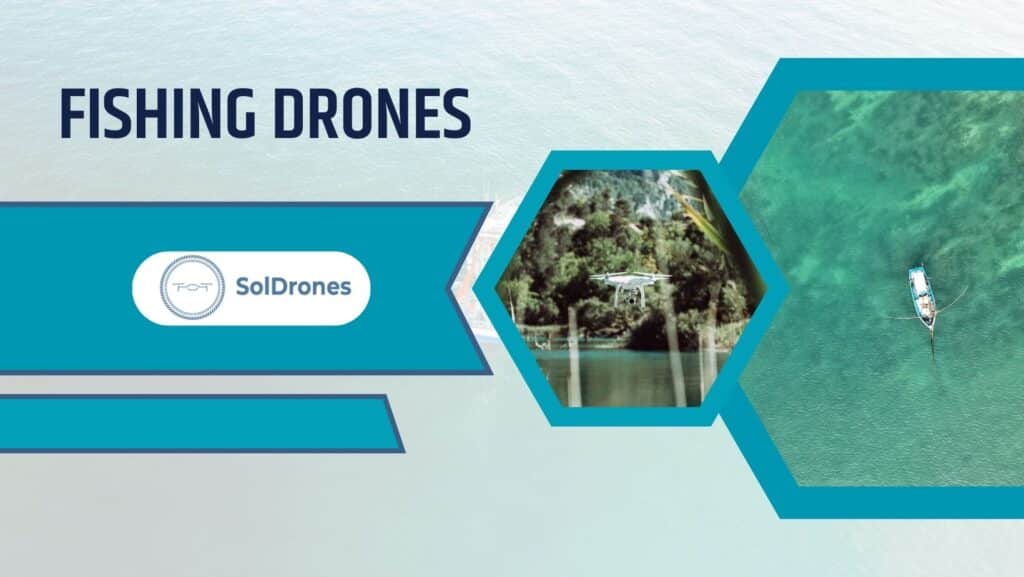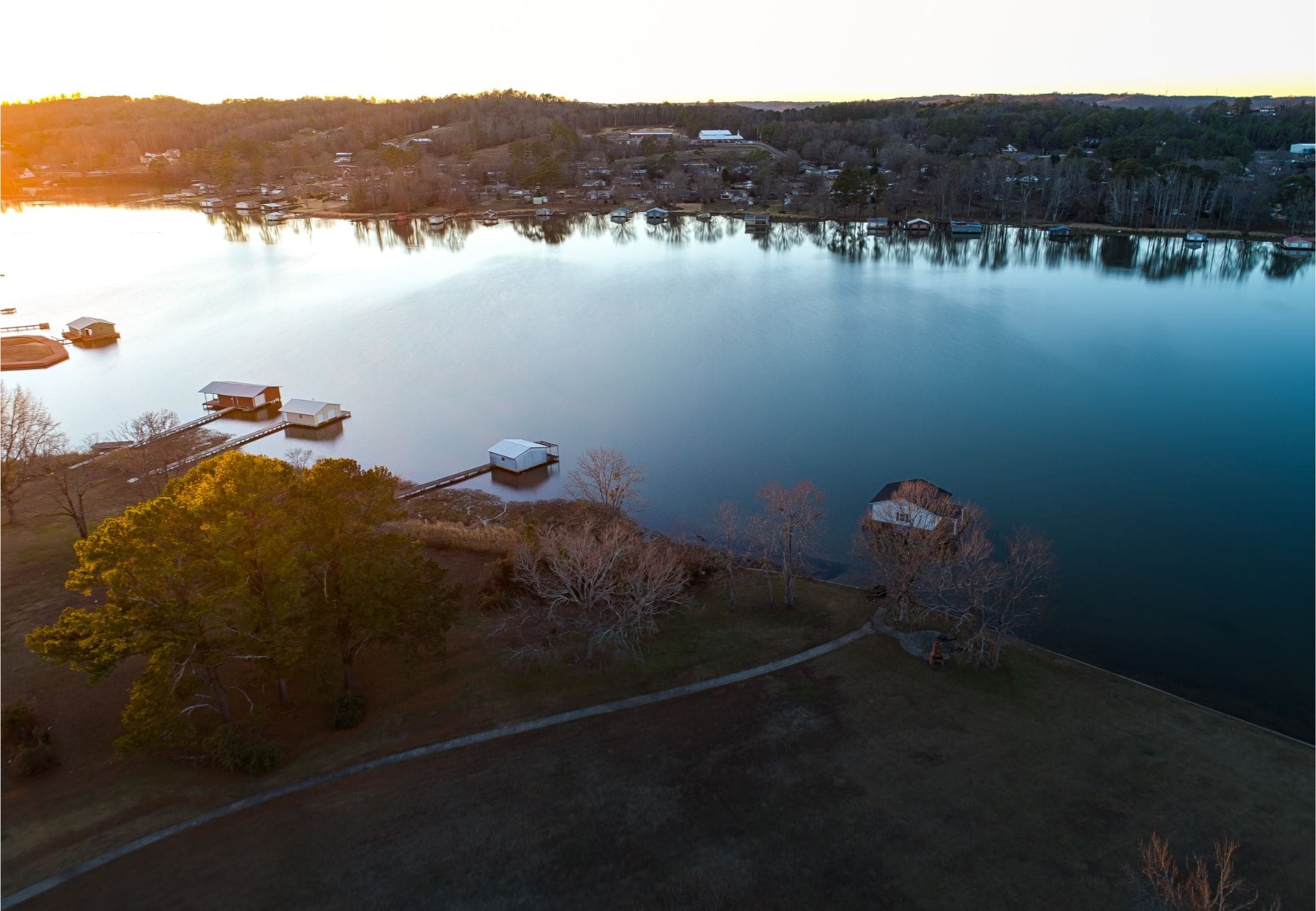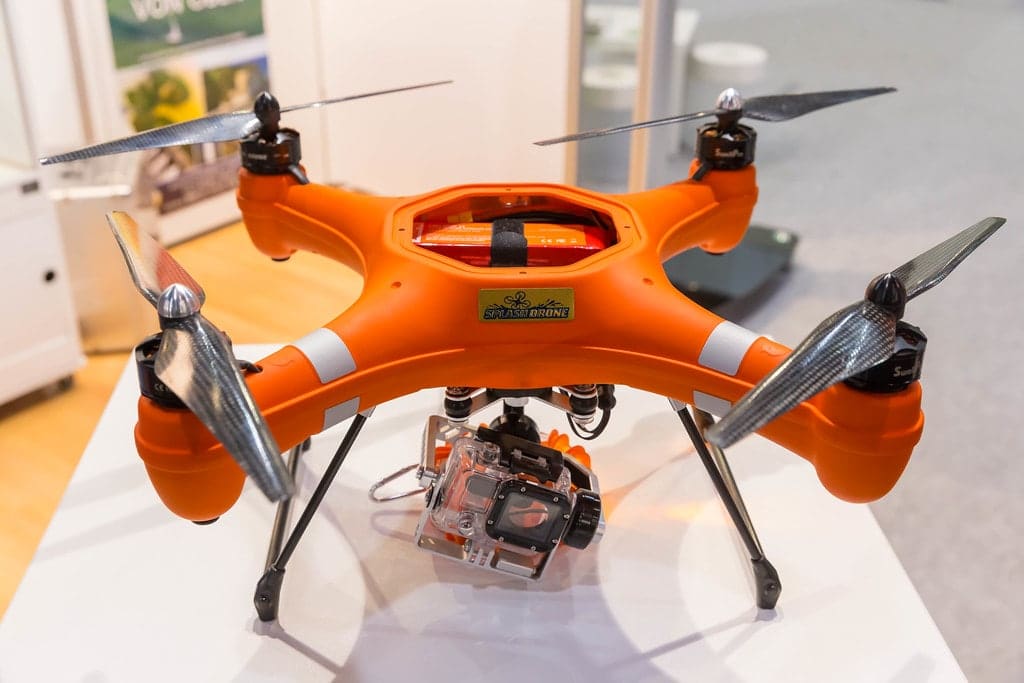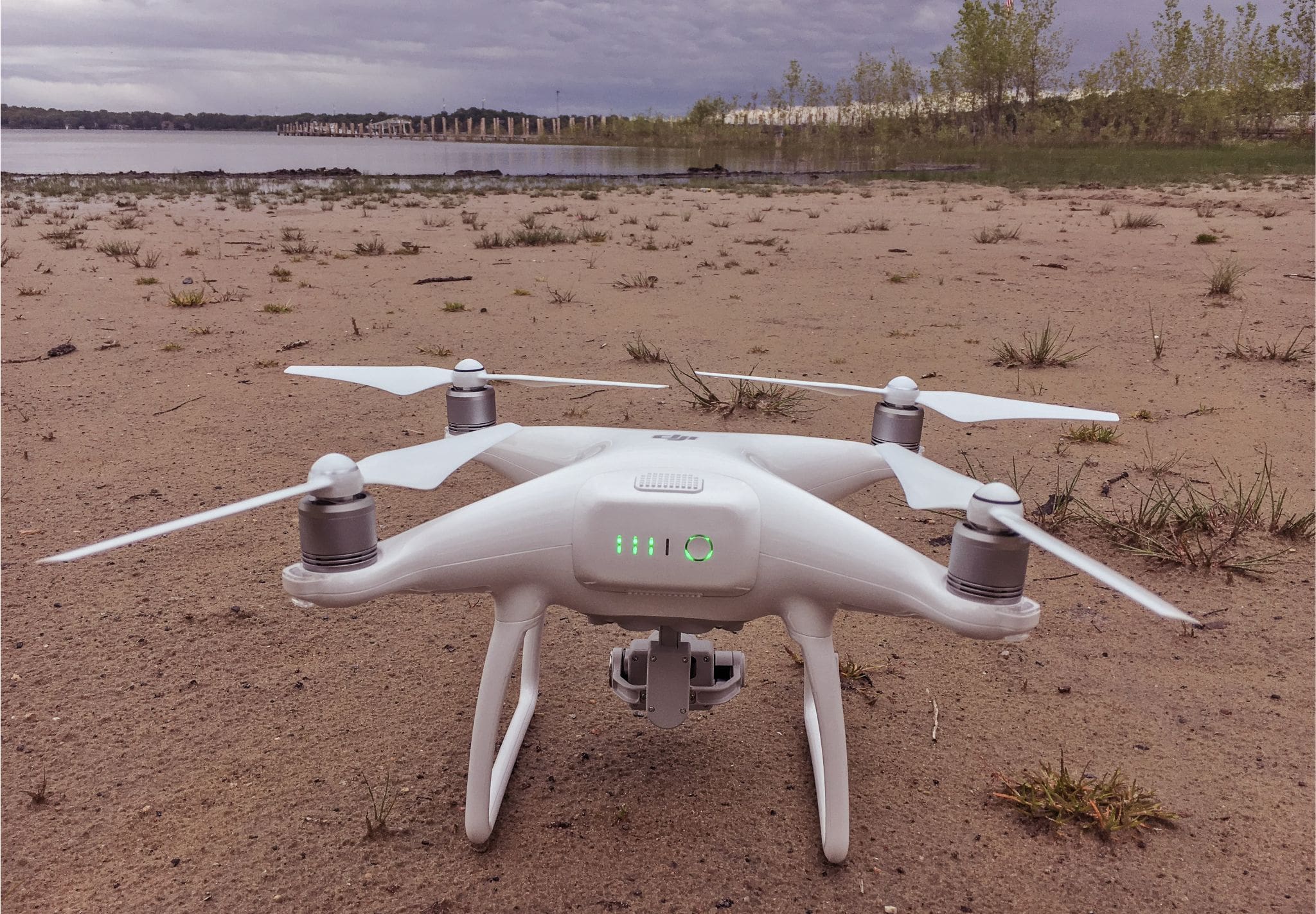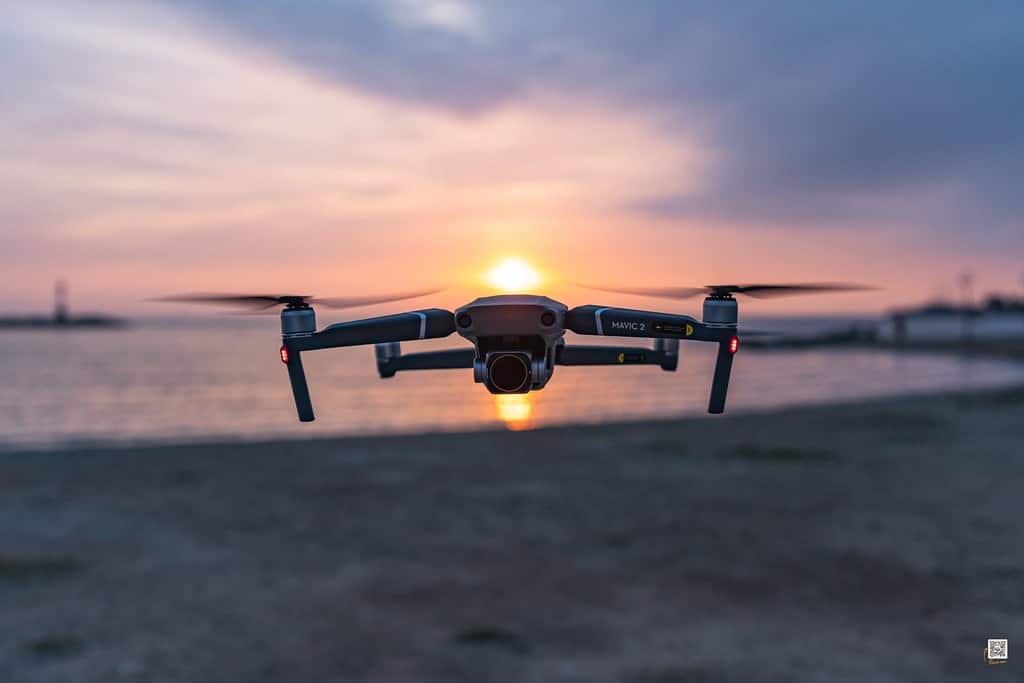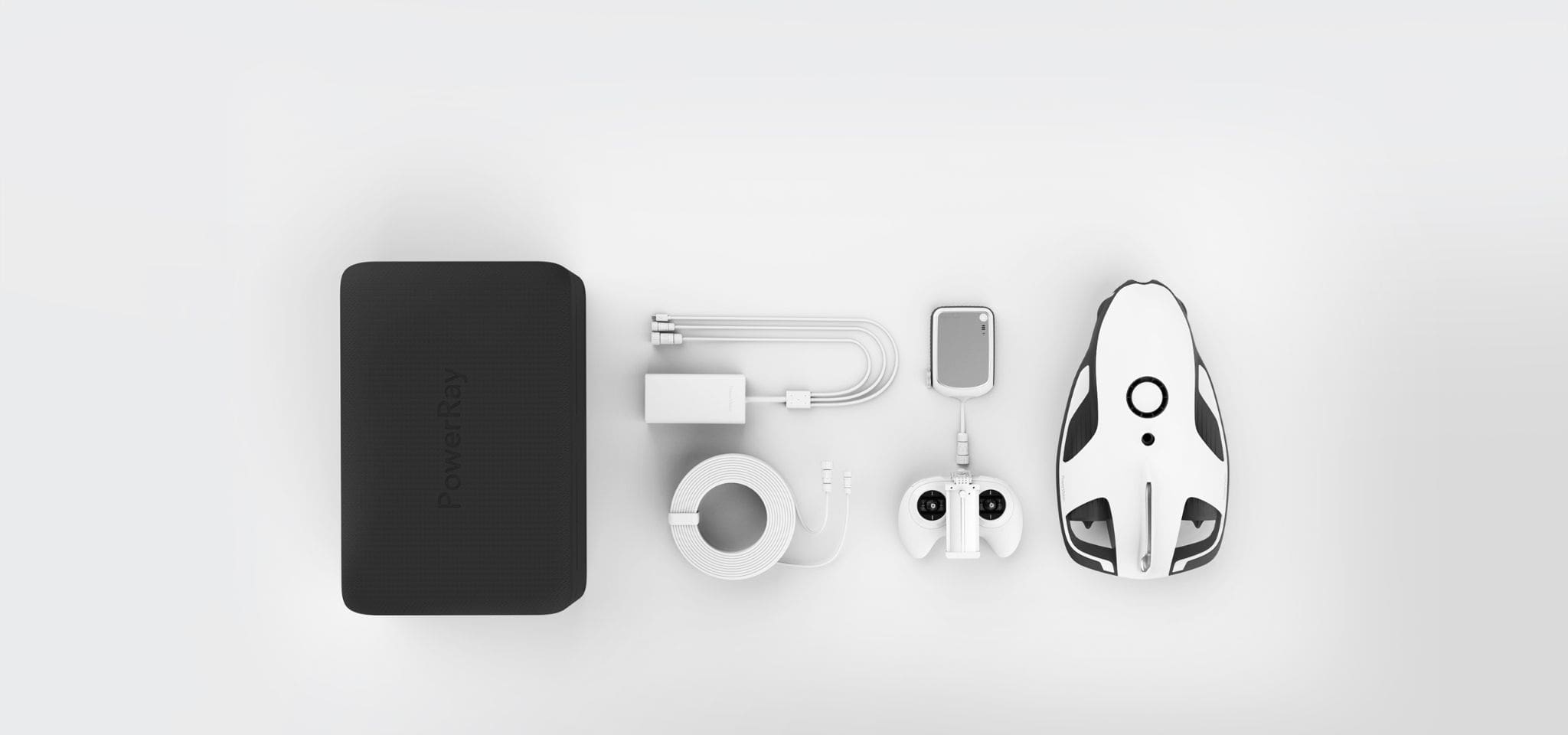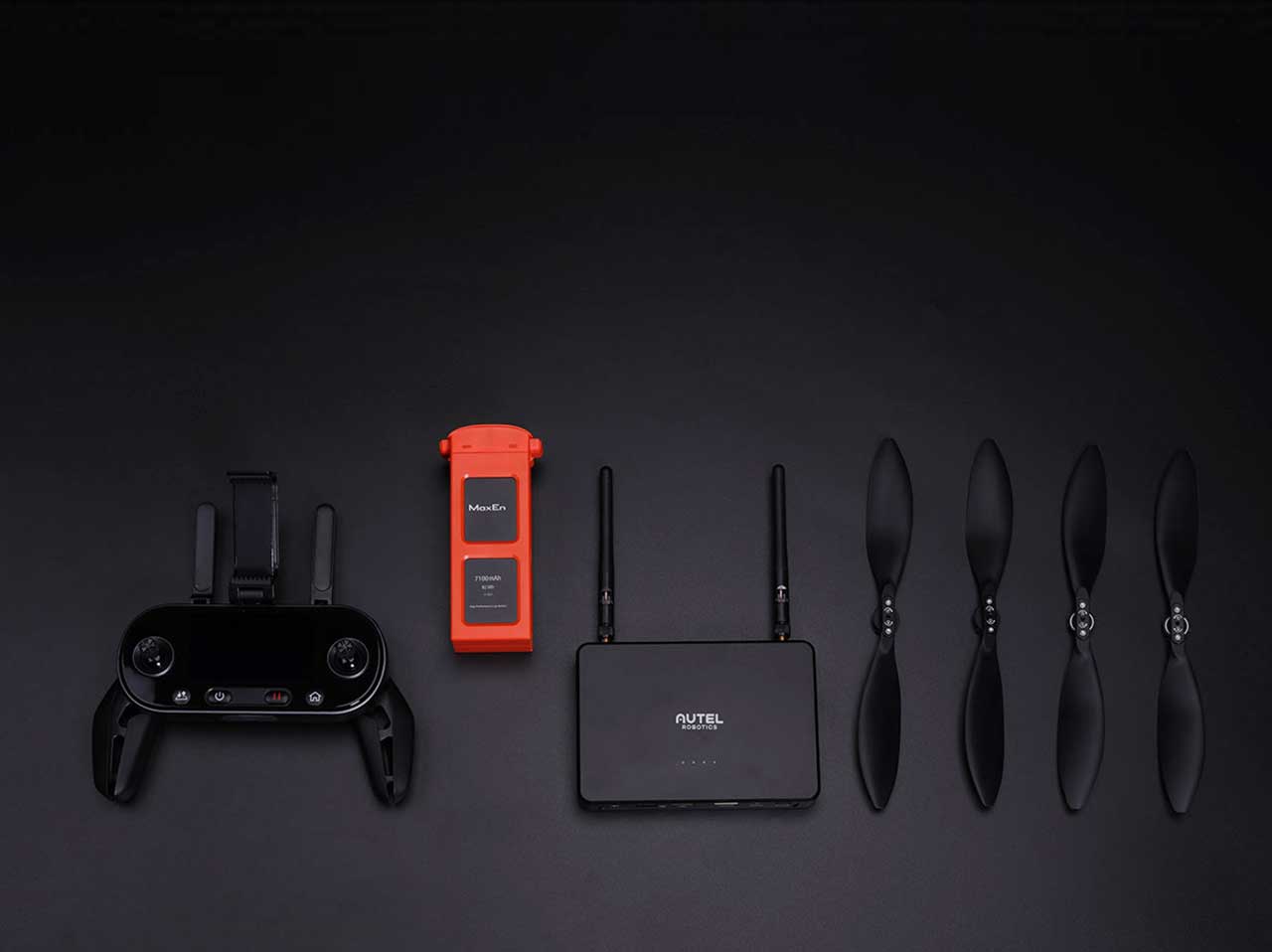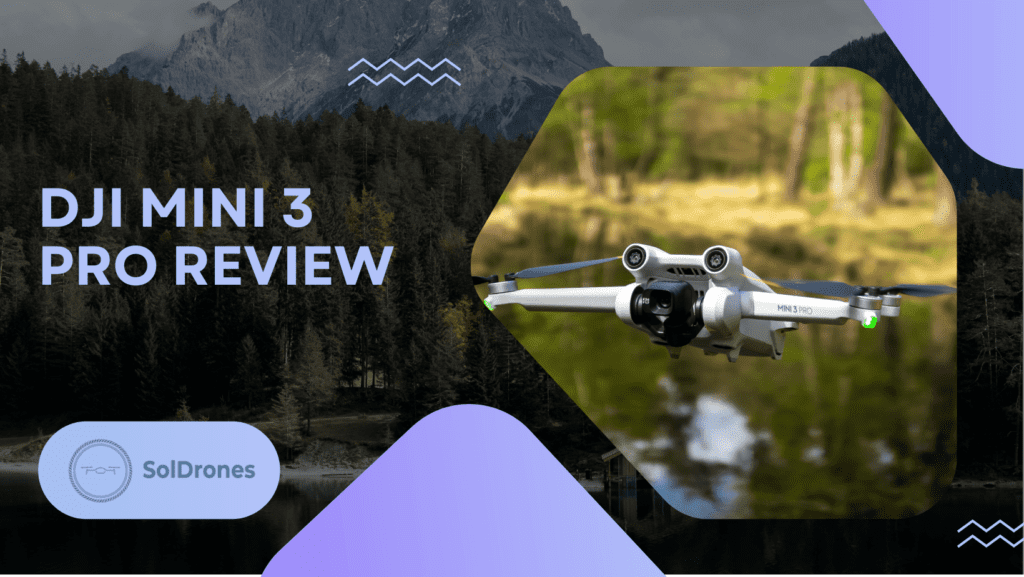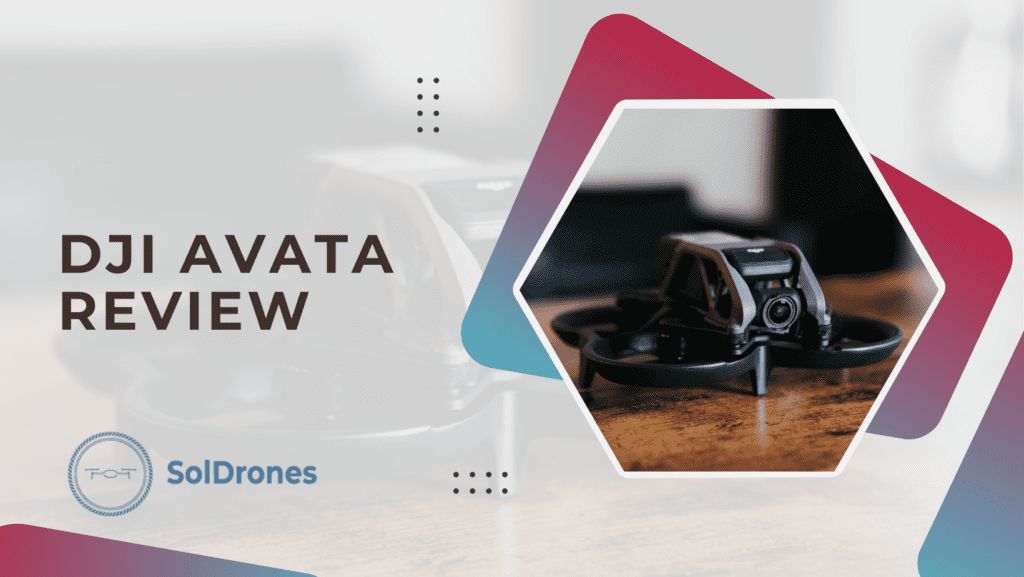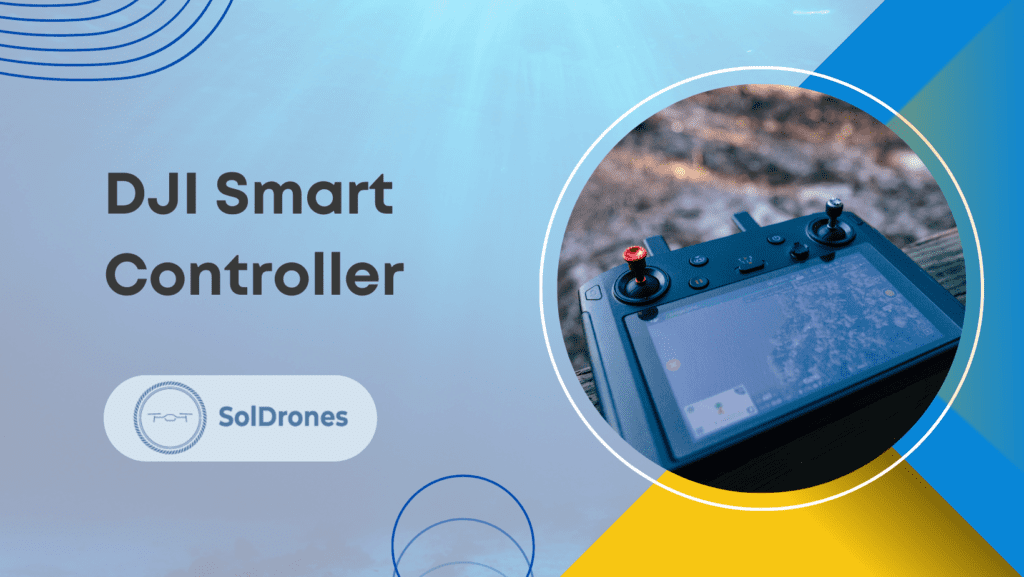Fishing with drones might be the next big trend in watersports, so if you’re reading this, you’re setting the curve.
You can uses an aerial drone to spot fish in a river or lake, or you can literally fish with the drone by repelling down a bait and hook.
This article explores how you can get into this new sport as a fisherman or drone pilot. If you’re looking to cut right to the chase and purchase your first fishing drone, here’s a top recommendation:
SwellPro SplashDrone 4
The SplashDrone 4 by SwellPro is designed to be compatible with certain payload release mechanisms and camera attachments. You have the option to put together a specialized bundle with the right attachments you need such as a 4K camera, 3-Axis Gimbal, or payload release mechanism. Flight time is around 30 minutes, the payload is around 2kg, and of course this drone is waterproof with a floating design.
Article Highlights
- Fishing drones redefine angling, allowing access to remote, abundant catches beyond the shore’s limits.
- Insights on drone fishing dynamics, from initial setup to precise bait release, showcasing enhanced strategic angling.
- Essential fishing drone features for effective angling focuses on compliance with legal standards and environmental care.
What Are Fishing Drones?
Fishing drones are specialized unmanned aerial vehicles (UAVs) that assist anglers in finding and catching fish.
Video Credit: SwellPro
These drones are equipped with features such as high-definition cameras, remote control, GPS, and sometimes payload release mechanisms, allowing fishermen to scout for fish in the water, cast bait accurately, and even carry the fishing line to remote, hard-to-reach locations.
By providing an aerial view, fishing drones help identify schools of fish, suitable water conditions, and other environmental insights that are typically beyond the reach of shore-based or boat-based anglers.
They enhance traditional fishing methods, offering efficiency, reach, and a technological edge in recreational and sport fishing scenarios.
How Does Drone Fishing Work?
Fishing drones operate by integrating modern drone technology with the traditional fishing process, providing a unique advantage through aerial perspectives, remote casting, and precise bait delivery. Here’s how they work:
Preparation and Launch
Before starting, anglers attach fishing line rigging or a bait release mechanism to the drone. These specialized attachments are designed to carry and release the fishing line, hook, and bait at the angler’s discretion.
The drone is then launched and ascends to provide a bird ‘ s-eye view, which is used for scouting locations with fish.
Locating Fishing drone
Equipped with high-resolution cameras and remote control, fishing drones fly over the water, allowing anglers to view live footage transmitted to a smartphone or other device.
This capability identifies fish schools, water conditions, and other environmental factors influencing fishing success.
Some advanced models may also incorporate sonar or other aquatic sensing technologies to assist in locating fish beneath the surface.
Bait Casting and Delivery
Once an ideal spot is located, anglers pilot the drone to position it for casting using the remote control. The surf fishing line, attached to a release mechanism on the drone, carries the bait as the drone flies.
When over the target area, the angler remotely triggers the release mechanism, and the bait is dropped along with the hook and a portion of the surf fishing line into the water.
Fishing Process
After casting, the drone is typically flown back to the angler, leaving the line in the water. Anglers then go fishing using the rod and reel as they would in traditional methods.
The bite and catch processes remain largely the same, though the drone allows for casting in locations that might be unreachable with standard casting techniques.
Retrieval and Repeat
If a catch is made, anglers reel in the fish manually. If not, the drone can retrieve the line and bait for another attempt or to try in a new location.
The process can be repeated, allowing efficient searching and casting in multiple locations during a fishing trip.
By expanding the angler’s reach, providing data on water conditions, and enabling precise bait placement, fishing drones revolutionize the fishing experience.
They merge technological advancements with traditional practices, making fishing more efficient and often more successful.
However, users must operate within local regulations, as certain areas may restrict drone usage.
What Should I Look For In A Fishing Drone?
Not all drones are suitable for fishing. While some drones can be adapted for fishing purposes, specific features make drones more effective and practical for fishing activities.
Choosing the right fishing drone involves considering several key factors to ensure it can perform the tasks required effectively and withstand the challenges of a fishing environment.
Here are essential features and specifications:
- Load Capacity: A fishing drone must have a strong carrying capacity to transport bait and the fishing line. Ensure the drone can handle the weight without compromising its stability or flight performance.
- Battery Life: Look for drones with a long battery life to spend more time flying and less time charging. This feature is crucial, especially in fishing, where finding the right spot might take time.
- Range: The drone should have a long-range communication system that allows you to control it from a significant distance. This way, you can reach farther spots in the water than you normally could not with casting.
- Water-Resistant or Waterproof: Given the high likelihood of coming into contact with water, water-resistant or waterproof fishing drones are ideal. Some drones are designed to land on and take off from water, providing an additional advantage.
- Stable and Smooth Flight: The drone needs to have reliable and stable GPS and flight characteristics, ensuring it can hover stably in place, even in windy conditions, for precise drop baits.
- High-Quality Camera: A high-resolution camera is vital for spotting larger fish and inspecting the water conditions. A three-axis gimbal to stabilize the camera can also be very beneficial.
- Bait Release Mechanism: The drone should be equipped with or compatible with a reliable mechanism for bait release, allowing you to drop the fishing line at the desired location accurately.
- Durability: Fishing environments can be tough on equipment, so ensure the drone is robust and built with durable materials, capable of withstanding harsh conditions.
- Return to Home Feature: In case of signal loss or low battery, the drone should have an automatic ‘Return to Home’ feature to prevent losing it in water.
- User-Friendly Operation: Especially if you’re new to drones, having a user-friendly interface for navigation, operation, and features like one-touch takeoff and landing can be very helpful.
- Regulatory Compliance: Ensure the drone complies with local drone flying and fishing regulations before purchasing. This might include weight, range, and feature restrictions.
- After-Sales Support: Good manufacturer support, warranty, and easy availability of spare parts can be crucial in the long-term usability of your fishing drone.
Investing in a drone with these features enhances your fishing experience, expanding your capabilities far beyond the limitations of shore or boat fishing.
Always operate within drone use guidelines to protect wildlife and avoid legal issues.
Are Fishing Drones Legal?
The legality of drone fishing in the United States is a complex issue with varying federal, state, and local regulations. While no explicit federal law prohibits drone fishing, it is subject to existing drone regulations and fishing regulations.
According to the Federal Aviation Administration (FAA), drones are considered “aircraft” subject to federal regulations. These regulations include:
- Registration: Drones weighing more than 0.55 pounds must be registered with the FAA.
- Licensing: Recreational drone pilots must pass an aeronautical knowledge test and obtain a Remote Pilot Certificate.
- No-Fly Zones: Drones are prohibited from flying in certain areas, such as near airports, military bases, or critical infrastructure.
- Altitude and Distance Limits: Drones must be flown below 400 feet and within the visual line of sight of the operator.
In addition to federal regulations, individual states may have their laws regarding drone fishing. Some states have specific restrictions on using drones for fishing, while others may prohibit using drones for hunting or wildlife harassment. It is crucial to check the specific regulations in your state before engaging in drone fishing.
Furthermore, drone fishing is still subject to general fishing regulations, such as:
- Fishing License: Anglers may need a valid fishing license to use a drone for fishing purposes.
- Catch Limits and Restrictions: Drone fishing is subject to catch limits, size restrictions, and protected species regulations.
- Local Restrictions: Some areas may have specific restrictions on drone fishing, especially in marine reserves or protected waterways.
It is essential for drone anglers to stay informed about the specific regulations in their area and to comply with both drone and fishing rules. Responsible drone fishing practices should also be followed to minimize environmental impact and ensure safety for other anglers and wildlife.
Here are some general guidelines for responsible drone fishing:
- Respect Wildlife: Avoid disturbing wildlife or causing harm to marine animals.
- Minimize Disturbance: Operate the drone to minimize noise and disturbance to other anglers and wildlife.
- Dispose Properly: Dispose of fishing lines and tackle responsibly to prevent entanglement or pollution.
- Be Considerate: Be mindful of other anglers and avoid interfering with their fishing activities.
By following these guidelines and adhering to local regulations, anglers can enjoy the benefits of drone fishing while ensuring responsible and sustainable practices.
How To Use A Drone For Fishing?
Using a drone for fishing can greatly enhance your ability to find fish and reach remote, hard-to-access spots.
Here’s a step-by-step guide on using a drone for fishing:
Step 1: Preparation
- Read the Manual: Before you even venture out, familiarize yourself with your drone’s operating instructions. Understand its controls, features, and safety protocols.
- Check Regulations: Comply with local fishing and drone flight regulations. Some areas have specific rules regarding drone use.
- Charge Batteries: Fully charge all batteries, and consider bringing spares to extend your drone’s operational time.
- Pack Necessary Gear: This includes your fishing rod, bait, fishing line, and drone accessories like a release mechanism or extra propellers.
Step 2: Setup
- Inspect the Drone: Check the drone’s components, ensuring everything is intact and the firmware is up to date.
- Attach Fishing Gear: Securely attach your fishing line to the drone using a release mechanism. Special riggings and release mechanisms designed for drone fishing will release the line on your command or if a fish strikes.
- Test the Setup: Do a test flight on land to ensure the release mechanism and drone controls are functioning properly.
Step 3: Launching
- Find a Suitable Area: Launch your drone from a clear, open space for obstacle avoidance in any accidents.
- Calibrate and Launch: Follow specific calibration procedures for your drone, if necessary, and then take off, ensuring it’s stable.
Step 4: Locating Fish
- Use the Camera: Fly your drone over the water, using its camera to spot schools of fish or larger fish. The bird’s-eye view allows you to cover large areas more quickly than traditional methods.
- Record or Mark Fishing Spots: Some drones for fishing allow you to mark GPS coordinates or record your flight path so you can return to specific fishing spots.
Step 5: Casting and Bait Release
- Position Your Drone: Once you’ve located your spot, stabilize your drone over the area. Ensure it’s positioned correctly for casting your bait.
- Release the Bait: Drop your baited hook and line into the water using the drone’s release mechanism. The bait should be attached to disconnect from the drone but remain on the fishing line.
Step 6: Fishing
- Return the Drone: Once the bait is in the water, fly your drone back to shore or your boat to conserve battery life. Your fishing rod should now take over the process.
- Wait for a Bite: Fish as you would normally, waiting for a bite and ready to reel in your catch.
Step 7: Retrieval and Repeat
- Reeling in the Catch: If you catch a fish, reel it in. If not, you can use the drone to retrieve the bait or move it to a new location.
- Repeat the Process: Continue scouting, casting, and reeling in as desired or until your drone’s battery runs low.
Step 8: Post-Fishing
- Clean and Store Equipment: Rinse your drone with fresh water to prevent corrosion, especially if used over salt water. Check for any damage and store it properly, following any storage guidelines in the user manual.
- Review Footage: If you recorded your session, review the footage to study fish behavior or note any productive spots for future reference.
Using a drone adds a novel and technologically advanced element to fishing, potentially improving your success rate. However, responsible use is paramount to ensure safety and compliance with legal and environmental regulations.
What Are The Best Drones For Surf Fishing?
The best fishing drones combine long-range and flight time capabilities, robust build quality, water resistance, and useful features like high-quality cameras and reliable bait release mechanisms.
Here are some drones renowned for their performance in fishing scenarios:
Swellpro Splash Drone 3+ or 4
Swellpro Splash 4 is one of the most popular waterproof fishing drones specifically designed for fishing and marine applications.
These Swellpro Drone can land on and take off from fresh or saltwater. The splash drone is a low-cost drone with a payload release mechanism. Also, these Swellpro drones can float on sea, and include modular options like fish finders.
DJI Phantom 4 Pro V2.0
Known for its exceptional camera quality, the DJI Phantom 4 Pro V2.0 offers stunning image clarity, which is crucial for spotting fish. This feature makes it the best drone for fishing.
Though not specifically designed for fishing, its robust design, long battery life, and precise controls make it a favorite among fishers who use a separate payload release mechanism.
DJI Mavic 2 Pro/Zoom
While these DJI drones require additional payload release mechanisms for fishing, their compact size, extended flight time, excellent camera quality (with the Pro featuring a Hasselblad camera and UHD 4K camera), and range make them suitable for the task. The advanced technology and portability of these DJI drones are significant plus points for fishermen. The DJI Mavic 2 Pro would be an ideal choice for a fishing drone.
PowerVision PowerRay
While not an aerial drone, the PowerRay is the best drone for underwater fishing. It includes a fish finder, a bait drop device and line, and an integrated 4K camera (UHD), providing a unique approach to locating and catching fish.
Autel Robotics EVO II
Known for its HD camera with 8K video capability, robust construction, and long flight time, the EVO II is the best drone for fishing adventures when equipped with a payload release accessory.
It provides exceptional image detail and has an impressive transmission range.
When choosing a fishing drone, consider the drone’s compatibility with fishing-related accessories, local regulations regarding drone use, and your specific fishing needs.
Additionally, the fast-evolving drone market means new and improved models may be available, offering advanced features suitable for fishing. Always check the latest reviews and product details before making a purchase.
Remember, the use of drones also comes with the responsibility to adhere to regional drone flight regulations and respect the natural environment, ensuring that the technology is used sustainably and ethically in fishing practices.
What Is The Range Of A Fishing Drone?
The range of a fishing drone varies depending on the specific model, its transmission technology, and environmental factors.
However, most fishing drones range from 1 to 3 kilometers (0.6 to 1.9 miles). Some high-end models may range up to 5 kilometers (3 miles) or more.
The range of a drone is primarily determined by the strength of its radio signal and its capacity for obstacle avoidance that can interfere with the signal.
Factors such as weather conditions, electromagnetic interference, and physical obstructions like trees or buildings can reduce the effective range of a drone.
It’s important to note that the maximum range manufacturers specify is often based on ideal conditions and may not be achievable in real-world scenarios.
Additionally, drone regulations often impose distance limits that restrict how far a drone can fly from the operator.
When using a fishing drone, it is crucial to operate within its safe operating range and maintain a visual line of sight with the drone. This ensures that you can maintain control of the drone and avoid potential hazards or interference.
Final Thoughts
Fishing drones represent a groundbreaking integration of technology into the age-old art of fishing, revolutionizing how anglers approach their craft.
These devices enhance the fishing experience by accessing hard-to-reach waters and increase each fishing trip’s efficiency and success rate through superior bait delivery and fish-finding capabilities.
As technology advances, the features of fishing drones continue to evolve, promising even more sophisticated capabilities, from detailed underwater imaging to advanced bait release mechanisms.
However, with this innovative tool comes the responsibility of maintaining ethical fishing practices and adhering to local regulations.
Balancing respect for marine life and ecosystems with the pursuit of angling challenges, fishing drones offer a modern twist to the timeless dance between humans and nature, adding a new, exciting chapter to the fishing tradition.
FAQs
Are fishing drones waterproof?
Not all fishing drones are waterproof. Some models are specifically designed to withstand water splashes or even float, essential for use over water bodies.
It’s important to check the drone’s specifications before purchasing or flying over water.
Can I use my regular drone for fishing?
While standard drones can be modified for fishing, they may lack specialized features like a bait release system, water resistance, or the necessary payload capacity.
Dedicated fishing drones are built to endure the environmental challenges associated with fishing and often come equipped with suitable fishing accessories.
What happens if the drone’s battery dies while over water?
Most advanced drones have a ‘Return to Home’ feature when the battery reaches a critically low level.
However, if the drone runs out of power entirely over water, it could crash and potentially be lost or damaged. It’s essential to monitor battery levels and weather conditions during flight.
Is it legal to fish with consumer drones?
Legal restrictions on drone fishing vary by country and region. Factors like wildlife disturbance, privacy, and safety come into play.
Before starting your drone-fishing expedition, it’s crucial to understand and comply with local regulations, including drone flight rules, fishing laws, and protected marine areas.
Do fishing drones scare away fish?
Fishing drones can cause disturbances, but many are designed to minimize noise and impact.
Successful drone fishing often depends on careful operation, such as maintaining an appropriate altitude and using a gentle bait release to avoid startling fish in the area.

